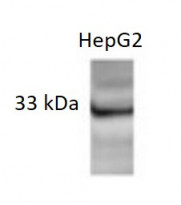ARG57513
anti-CIDE C antibody
anti-CIDE C antibody for Western blot and Human,Mouse
Overview
| Product Description | Rabbit Polyclonal antibody recognizes CIDE C |
|---|---|
| Tested Reactivity | Hu, Ms |
| Predict Reactivity | Rat |
| Tested Application | WB |
| Specificity | This antibody recognizes Human CIDE C. Sequence homology to the Mouse CIDE C homolog, FSP27, is 93%. |
| Host | Rabbit |
| Clonality | Polyclonal |
| Isotype | IgG |
| Target Name | CIDE C |
| Antigen Species | Human |
| Immunogen | KLH-conjugated synthetic peptide around aa. 10-25 of Human CIDE C. (LLYPKSLSRHVSVRTS) |
| Conjugation | Un-conjugated |
| Alternate Names | CIDE3; Fat-specific protein FSP27 homolog; Cell death-inducing DFFA-like effector protein C; Cell death activator CIDE-3; FSP27; CIDE-3; FPLD5 |
Application Instructions
| Application Suggestion |
|
||||
|---|---|---|---|---|---|
| Application Note | * The dilutions indicate recommended starting dilutions and the optimal dilutions or concentrations should be determined by the scientist. | ||||
| Positive Control | HepG2 cell lysate. |
Properties
| Form | Liquid |
|---|---|
| Purification | Purified by immunoaffinity chromatography. |
| Buffer | PBS (pH 7.4) |
| Storage Instruction | For continuous use, store undiluted antibody at 2-8°C for up to a week. For long-term storage, aliquot and store at -20°C or below. Storage in frost free freezers is not recommended. Avoid repeated freeze/thaw cycles. Suggest spin the vial prior to opening. The antibody solution should be gently mixed before use. |
| Note | For laboratory research only, not for drug, diagnostic or other use. |
Bioinformation
| Database Links | |
|---|---|
| Gene Symbol | CIDEC |
| Gene Full Name | cell death-inducing DFFA-like effector c |
| Background | This gene encodes a member of the cell death-inducing DNA fragmentation factor-like effector family. Members of this family play important roles in apoptosis. The encoded protein promotes lipid droplet formation in adipocytes and may mediate adipocyte apoptosis. This gene is regulated by insulin and its expression is positively correlated with insulin sensitivity. Mutations in this gene may contribute to insulin resistant diabetes. A pseudogene of this gene is located on the short arm of chromosome 3. Alternatively spliced transcript variants that encode different isoforms have been observed for this gene. [provided by RefSeq, Dec 2010] |
| Function | Binds to lipid droplets and regulates their enlargement, thereby restricting lipolysis and favoring storage. At focal contact sites between lipid droplets, promotes directional net neutral lipid transfer from the smaller to larger lipid droplets. The transfer direction may be driven by the internal pressure difference between the contacting lipid droplet pair. Its role in neutral lipid transfer and lipid droplet enlargement is activated by the interaction with PLIN1. May act as a CEBPB coactivator in the white adipose tissue to control the expression of a subset of CEBPB downstream target genes, including SOCS1, SOCS3, TGFB1, TGFBR1, ID2 and XDH. When overexpressed in preadipocytes, induces apoptosis or increases cell susceptibility to apoptosis induced by serum deprivation or TGFB treatment. As mature adipocytes, that express high CIDEC levels, are quite resistant to apoptotic stimuli, the physiological significance of its role in apoptosis is unclear. May play a role in the modulation of the response to osmotic stress by preventing NFAT5 to translocate into the nucleus and activate its target genes expression. [UniProt] |
| Calculated MW | 27 kDa |
| PTM | Ubiquitinated and targeted to proteasomal degradation, resulting in a short half-life. Protein stability depends on triaclyglycerol synthesis, fatty acid availability and lipid droplet formation (By similarity). [UniProt] |
Images (1) Click the Picture to Zoom In






